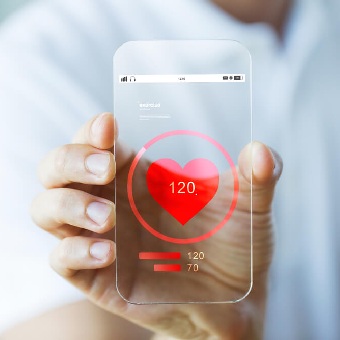



Get new exclusive access to healthcare business reports & breaking news




There’s no doubt that the COVID-19 pandemic has accelerated the timeline of innovation and adoption in the digital health and medtech industries. No vector of care is changing faster than outpatient care.
According to our previous analysis, digital healthcare must respond to industry demand for:
All of these priorities point to outpatient care. Medtech investors with as much as $4 trillion dollars in play are looking for home-runs out of the park—booming companies that leverage the expertise of leading MedTech-specific software developers like ScienceSoft to make game-changing, life-saving breakthroughs in technology.
Smart medtech investors should put smart technologies for outpatient care squarely in their crosshairs. Here are 5 technologies to watch out for …
mHealth stands for “mobile health,” referring to the practice of medicine via a mobile device. It’s a submarket of eHealth, or “electronic health,” which focused on computers prior to the ubiquity of mobile devices.
Mobile apps can promote medical education and awareness, communication between patients and medical providers, and notifications to support chronic disease management or regimen adherence.
mHealth also intersects with the booming interest in SaMD, which repurposes native features of popular mobile devices to perform the functions of medical devices. Consider the different functions performed by a mobile phone. SaMD apps have used …
According to Global Market Insights, more than 325,000 mHealth apps are available for iOS, WatchOS, or Android. Valued at $30.2 billion in 2018, the mHealth industry was expected to grow a whopping 38.5% CAGR from 2019 to 2025. With the increase in digital health interest, that number now seems conservative.
Enabling patients to perform more medical functions at home will reduce the pressure on hospital admissions, trending toward better outpatient services.
Telemedicine has drawn significant attention in an era when people want to spend as little time in waiting rooms—indeed, in the presence of coughing strangers—as humanly possible.
From a pure efficiency standpoint, telemedicine and telehealth—the use of remote communication to perform medical visits traditionally performed face-to-face—stands to alleviate the burden of inpatient admissions by relocating some of them to telehealth outpatient treatment. After all, if patients don’t need to go to the hospital to see their doctor or other provider, there will be fewer patients in the hospital.
Telemedicine isn’t just about a Zoom conference between a doctor and a patient. It also involves automated processes like simple data-driven diagnostics, as well as AI customer support and physician live-chats.
Spurred forward by COVID and the demand for outpatient services, the telemedicine market is expected to tip the scales at a whopping $185.66 billion by 2026, representing a 23.5% CAGR according to research by Fortune Business Insights.
Wearable devices are closely associated with devices like the FitBit and the Apple Health suite of fitness monitors on the Apple Watch. It’s not hard to imagine that these devices’ contribution to the overall fitness of the nation will reduce pressure on hospitals, with a healthier populace and fewer hospitalizations in total.
But wearable devices can also play a more direct role in facilitating successful outpatient care. Take Corrie, an iOS app that pairs with a WatchOS app to connect a user’s iPhone with their Apple Watch to monitor their aftercare in the aftermath of a cardiac incident—a heart attack or other heart disease hospitalization.
Corrie monitors the user’s heart rate, number of steps per day, and medication adherence. A study by Johns Hopkins revealed a 3% readmission rate for discharged heart patients using Corrie, compared to 19% for the control group.
Other SaMD apps are in development to monitor cardiac outpatient subjects’ breathing and circulation during the critical sleeping hours, enabling emergency responders to react quickly in the event of an incident, reducing the need for a long inpatient monitoring period.
Wearable devices, forecast to represent a $51.6 billion industry by 2022, have a critical role to play in the improvement of outpatient outcomes.
Fewer patients need hospitalization if they can be monitored outside of the hospital. Outpatient care has received, and will continue to receive, a huge boost through remote monitoring—the use of WiFi, cellular data, and other forms of Cloud connectivity to monitor patient vitals from anywhere in the world.
We’ve covered some of the roles that SaMD plays in this process, but equally important is the Internet of Medical Things (IoMT), a subset of the IoT that consists of the network of medical devices connected to the internet. Examples include:
These devices not only feed a wealth of data to the medical provider, which can be parsed for patterns by AI learning machines. They also provide an avenue for fast response in the event of an emergency, reducing the need for long inpatient monitoring periods.
Measured at $24.4 billion in 2019, the IoMT is expected to surpass $285.5 billion by 2029, a CAGR of 28%, according to Prophecy Market Insights.
Portal technologies are not new—practically every web enterprise has a member portal. But the sensitivity of medical data and HIPAA concerns places extra burden on the creation of medical portals and the kind of information that can be accessed from them.
But medtech companies are rising to that challenge, using advanced encryption to give patients “anywhere” access to medical data captured at clinic visits, or by wearable devices, IoMT devices, SaMD, etc. It also enables result-monitoring of mail-in tests available to test for prediabetes, heart disease markers, sexually-transmitted diseases, even COVID-19 itself.
Secure patient portals will facilitate the transition to more effective outpatient care by providing better access to inpatient records.
————————————————————————————
Advances in healthcare technology and Medtech will define the next century in pursuit of a better and better quality of life. Effective investment will help reduce the amount of time patients spend in the hospital, without sacrificing favorable outcomes. That’s better for everyone’s health and happiness—providers and patients.